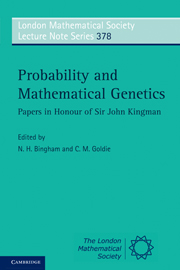Book contents
- Frontmatter
- Contents
- List of contributors
- Preface
- Bibliography of J. F. C. Kingman
- 1 A fragment of autobiography, 1957–1967
- 2 More uses of exchangeability: representations of complex random structures
- 3 Perfect simulation using dominated coupling from the past with application to area-interaction point processes and wavelet thresholding
- 4 Assessing molecular variability in cancer genomes
- 5 Branching out
- 6 Kingman, category and combinatorics
- 7 Long-range dependence in a Cox process directed by an alternating renewal process
- 8 Kernel methods and minimum contrast estimators for empirical deconvolution
- 9 The coalescent and its descendants
- 10 Kingman and mathematical population genetics
- 11 Characterizations of exchangeable partitions and random discrete distributions by deletion properties
- 12 Applying coupon-collecting theory to computer-aided assessments
- 13 Colouring and breaking sticks: random distributions and heterogeneous clustering
- 14 The associated random walk and martingales in random walks with stationary increments
- 15 Diffusion processes and coalescent trees
- 16 Three problems for the clairvoyant demon
- 17 Homogenization for advection-diffusion in a perforated domain
- 18 Heavy traffic on a controlled motorway
- 19 Coupling time distribution asymptotics for some couplings of the Lévy stochastic area
- 20 Queueing with neighbours
- 21 Optimal information feed
- 22 A dynamical-system picture of a simple branching-process phase transition
- Index
2 - More uses of exchangeability: representations of complex random structures
Published online by Cambridge University Press: 07 September 2011
- Frontmatter
- Contents
- List of contributors
- Preface
- Bibliography of J. F. C. Kingman
- 1 A fragment of autobiography, 1957–1967
- 2 More uses of exchangeability: representations of complex random structures
- 3 Perfect simulation using dominated coupling from the past with application to area-interaction point processes and wavelet thresholding
- 4 Assessing molecular variability in cancer genomes
- 5 Branching out
- 6 Kingman, category and combinatorics
- 7 Long-range dependence in a Cox process directed by an alternating renewal process
- 8 Kernel methods and minimum contrast estimators for empirical deconvolution
- 9 The coalescent and its descendants
- 10 Kingman and mathematical population genetics
- 11 Characterizations of exchangeable partitions and random discrete distributions by deletion properties
- 12 Applying coupon-collecting theory to computer-aided assessments
- 13 Colouring and breaking sticks: random distributions and heterogeneous clustering
- 14 The associated random walk and martingales in random walks with stationary increments
- 15 Diffusion processes and coalescent trees
- 16 Three problems for the clairvoyant demon
- 17 Homogenization for advection-diffusion in a perforated domain
- 18 Heavy traffic on a controlled motorway
- 19 Coupling time distribution asymptotics for some couplings of the Lévy stochastic area
- 20 Queueing with neighbours
- 21 Optimal information feed
- 22 A dynamical-system picture of a simple branching-process phase transition
- Index
Summary
Abstract
We review old and new uses of exchangeability, emphasizing the general theme of exchangeable representations of complex random structures. Illustrations of this theme include processes of stochastic coalescence and fragmentation; continuum random trees; second-order limits of distances in random graphs; isometry classes of metric spaces with probability measures; limits of dense random graphs; and more sophisticated uses in finitary combinatorics.
AMS subject classification (MSC2010) 60G09, 60C05, 05C80
Introduction
Kingman's write-up of his 1977 Wald Lectures drew attention to the subject of exchangeability, and further indication of the topics of interest around that time can be seen in the write-up of my 1983 Saint-Flour lectures. As with any mathematical subject, one might expect some topics subsequently to wither, some to blossom and new topics to emerge unanticipated. This Festschrift paper aims, in informal lecture style,
(a) to recall the state of affairs 25 years ago (sections 2.1–2.3, 3.1);
(b) to briefly describe three directions of subsequent development that have recently featured prominently in monographs (sections 2.4, 3.1–3.2);
(c) to describe 3 recent rediscoveries, motivated by new theoretical topics outside mainstream mathematical probability, of the theory of representations of partially exchangeable arrays (sections 2.5, 5.1–5.2);
(d) to emphasize a general program that has interested me for 20 years. It doesn't have a standard name, but let me here call it exchangeable representations of complex random structures (section 4).
- Type
- Chapter
- Information
- Probability and Mathematical GeneticsPapers in Honour of Sir John Kingman, pp. 35 - 63Publisher: Cambridge University PressPrint publication year: 2010
- 11
- Cited by



